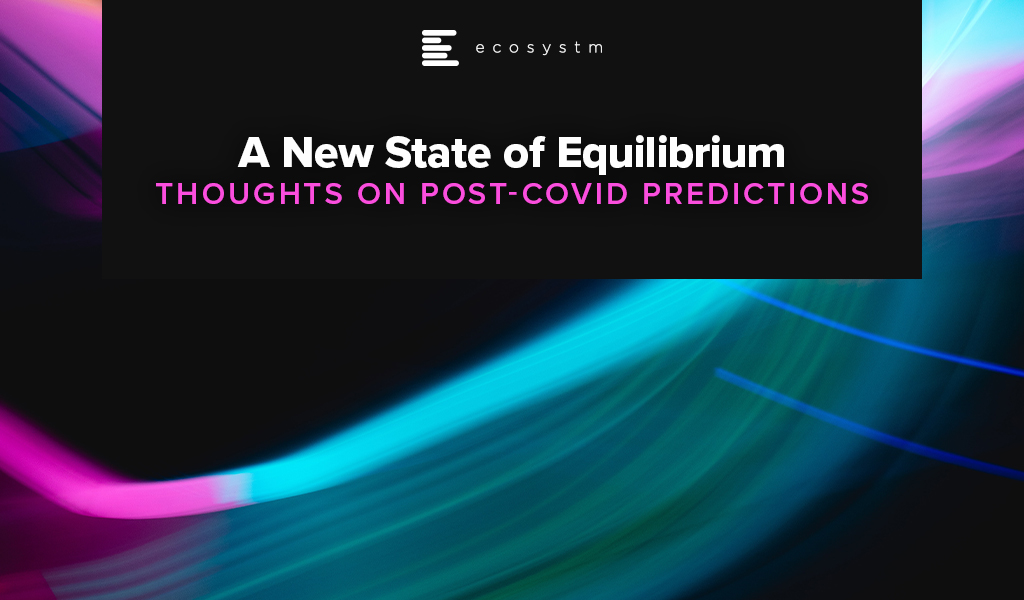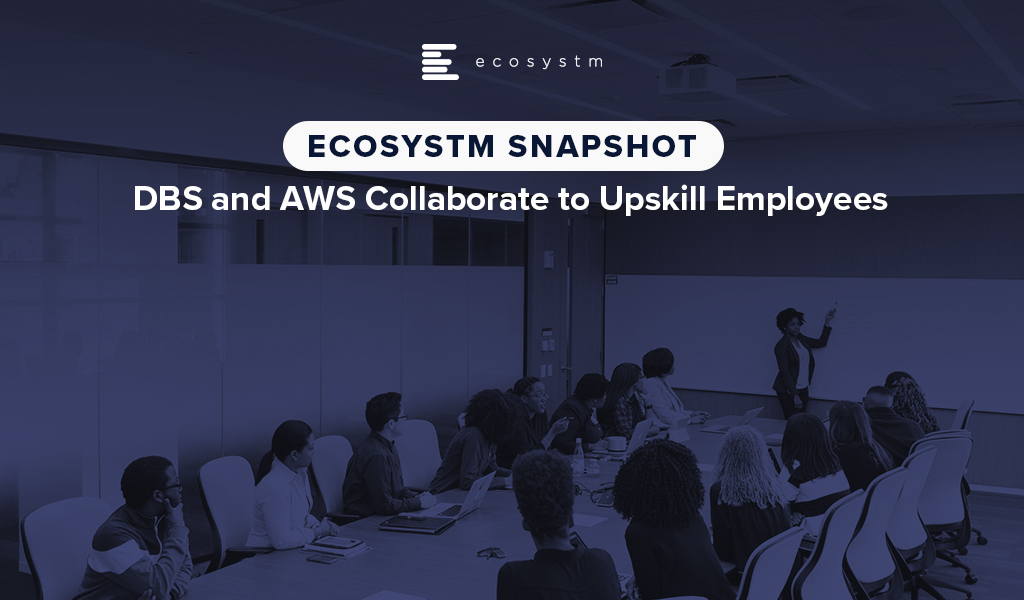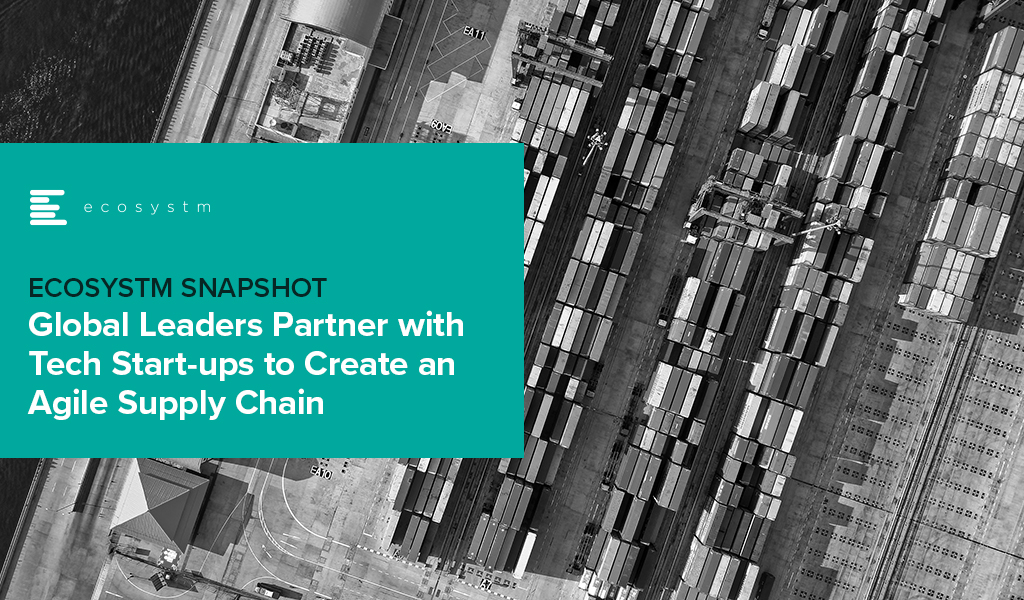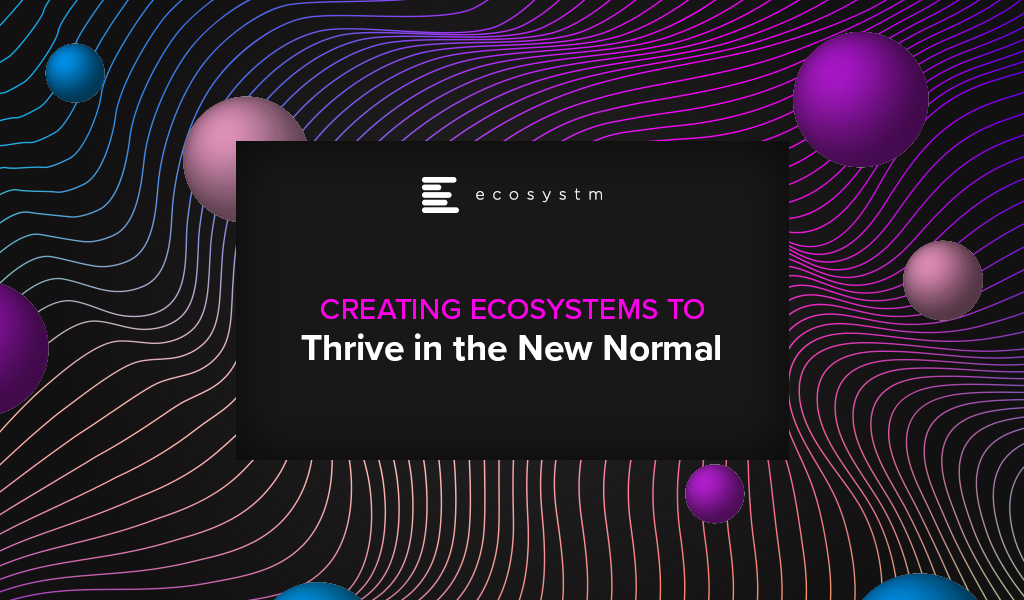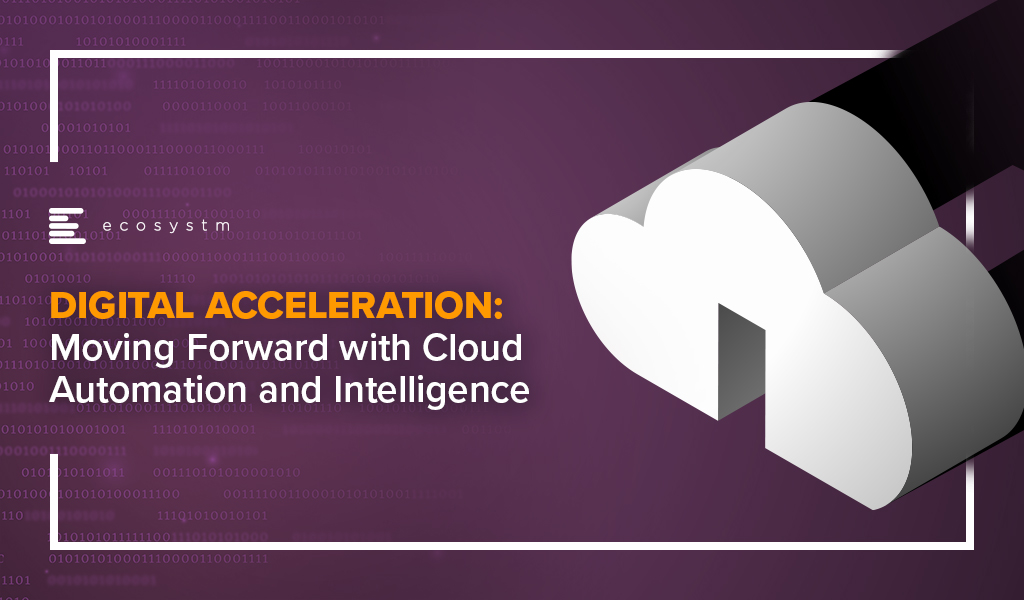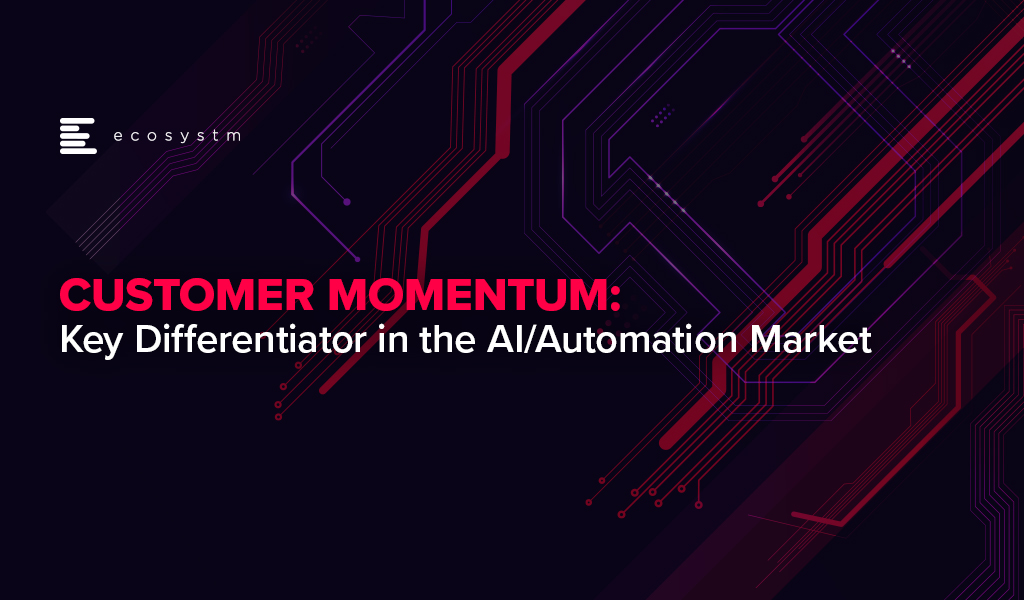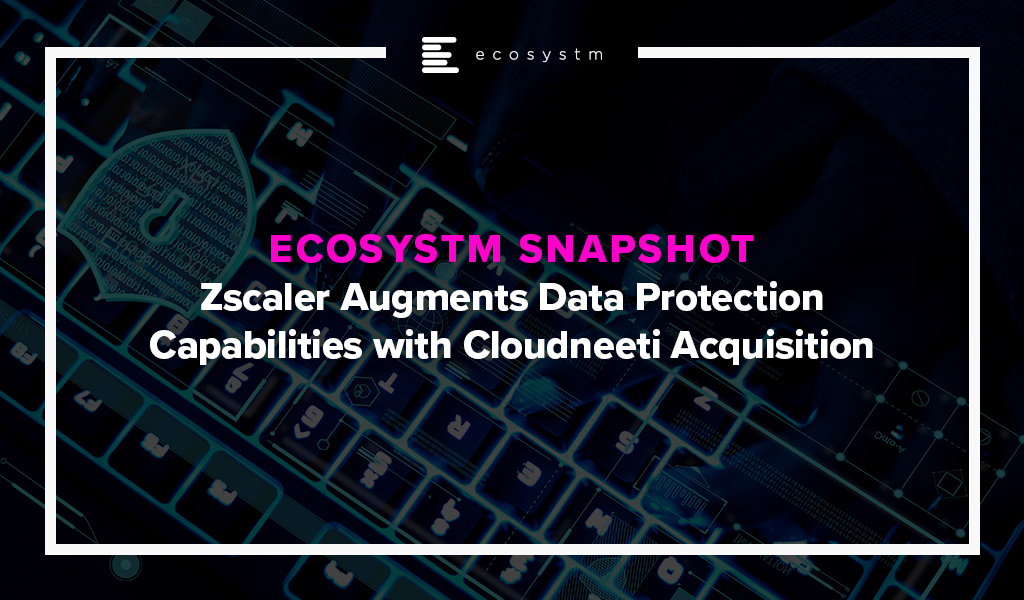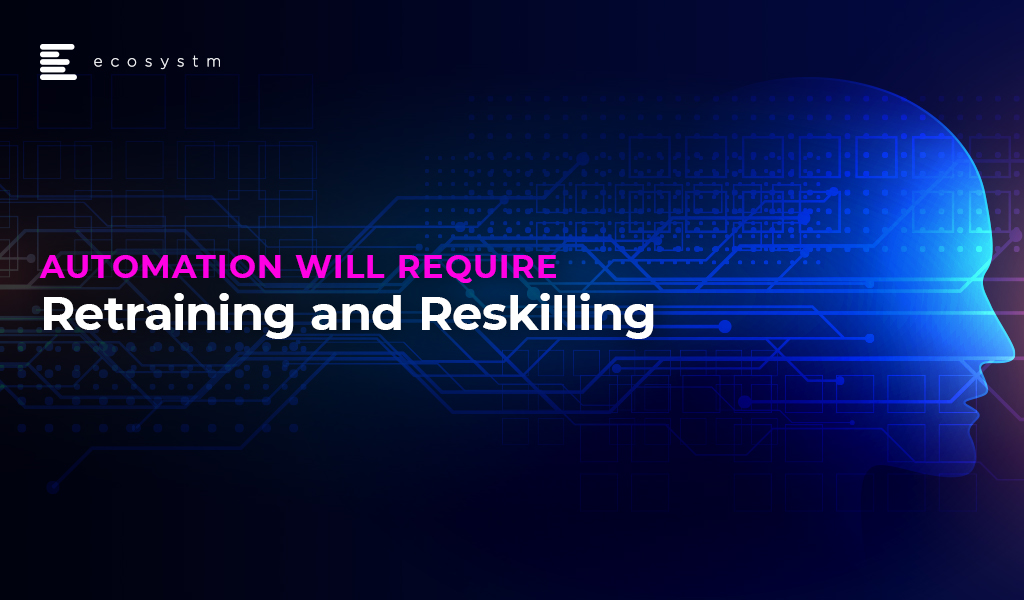I recently came across an article which makes 7 predictions for a post COVID world. Upon reflection, I agree with the predictions to varying degrees and decided to comment further.
First, let me share a couple of general observations. Currently, we are still in the eye of the storm. Many are unable to see any light at the end of the tunnel. There is quite a bit of negative sentiments, and some fail to see that the situation will ever improve. I am sure similar thoughts occurred during other crises: the 1918 Pandemic (Spanish Flu); the Great Depression of the 1930s; the Dot.com bust of 2001; SARS in 2003; and the Global Financial Crisis/Great US Recession of 2007. During each of these events, a sense of impending Armageddon came over much of the population. Certainly, in each instance, people did experience some personal and social permanent changes, with which they learned to adapt and cope. But, inevitably, the world did go on and Armageddon did not occur.
One of the basic truths I believe, is that humans require and crave interaction with other humans. Think about the videoconferencing applications. The use of these apps grew exponentially as the main communication channel. Instead of just audio, it was audio and video. These mediums greatly assisted society in coping and adapting. Mankind, and the Natural World, will always find a way.
Here are the predictions from the article:
- Companies that traffic in digital services and e-commerce will make immediate and lasting gains
- Remote work will become the default
- Many jobs will be automated, and the rest will be made remote-capable
- Telemedicine will become the new normal, signaling an explosion in med-tech innovation
- The nationwide student debt crisis will finally abate as higher education begins to move online
- Goods and people will move less often and less freely across national and regional borders
- After an initial wave of isolationism, multilateral cooperation may flourish
I very much agree with the author’s first prediction. This one is fairly obvious, as it has proven true throughout the crisis with providers such as Amazon, Zoom and others. It is expected to continue into the post COVID world. This is also evident from the findings of the Ecosystm research on the impacts of COVID-19. Organisations intend to continue to use digital technologies, even after the immediate crisis is over (Figure 1).
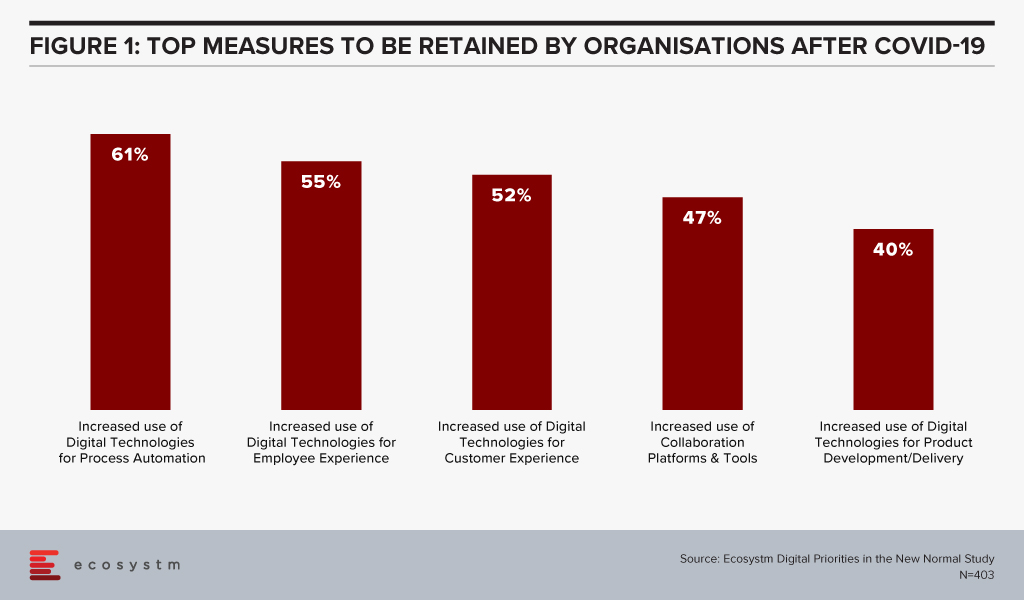
A Natural State of Equilibrium will Emerge
I believe for each of the areas described in the predictions, there will be various levels of long-term modification. None of them will return to their pre COVID-19 state, as we have all experienced going down the rabbit hole. During the pandemic, due largely to the lockdowns, the pendulum swung significantly towards one side. Many times, when people predict a new view, the current state is considered the New Normal. For me, the relevant question is: Will things stay as they are now, or will there be a new natural state of equilibrium? If so, what will it look like, in each of these areas? I don’t believe there is one answer, or one New Normal for all the dimensions being discussed. I believe a new normal state will potentially be different for each individual, each company/entity and each condition. In a post COVID-19 world there could be 50 shades of grey in each of these areas.
One of the predictions states that remote work will become the default. It must be remembered that part of work is a collaborative effort. While video conferencing has enabled collaborative efforts, the importance of the accidental interaction at the break room, printer, etc. can’t be under-estimated. It is these unscheduled interactions that enable accidental collaboration which can lead to great solutions. Thus, there will be many shades to the Future of Work – there will not be one absolute.
A similar example is a prediction for higher education. Part of the learning process a university offers is interacting with people who are not similar to your background or beliefs. That is one of the benefits of a diverse university. Similar to the corporate environment, many different types of learning environments will enable a person to gain great experiences from the time at university.
The advantage of all these alternatives will be the additional options and benefits to people post COVID compared to the pre COVID-19 world. It will present many great opportunities for entrepreneurs and innovators, as well as end-users and consumers. It will create new and iterative ‘middle spaces’. It will be possible for a David to emerge and challenge a Goliath(s).
The two Chinese characters for the word ‘crisis’ are “danger” and “opportunity”. Just as we are in a dangerous time now, it has also presented new and different opportunities. Those opportunities will continue to exist even when the danger has passed. I am also reminded of the old expression “May you live in interesting times”. It very much applies to all of us now and in the future. I wish the same for all of you.
Stay Safe. Stay Healthy. Stay Mentally Positive.

Organisations are on a fast track to digitalisation. The Ecosystm Digital Priorities in the New Normal study finds that 60% of organisations anticipate increased use of digital technologies for process automation, even after the COVID-19 restrictions are lifted. One of the key challenges that these organisations will face is the lack of internal digital skills – especially in emerging technologies. One of the success metrics of any technology adoption is employee uptake. Without the necessary skills or understanding of the benefits of emerging technology, employees will largely shy away from digital offerings, even the ones that will make their work more efficient and their lives easier.
Organisations are realising the value of making their workforce future ready.
DBS Instilling Company-Wide Digital Culture
Far-sighted companies are collaborating with technology vendors and professional training providers to promote tech awareness and education to futureproof their workforce. DBS Bank in Singapore has collaborated with AWS to train and upskill 3,000 employees – including the leadership team – with AI and machine learning skills through gamification in a DBS x AWS DeepRacer League.
The AWS DeepRacer Leagues have been previously organised in several parts of the world, but the DBS x AWS DeepRacer will be the first to be organised at this scale. The league will enable DBS employees to get their hands-on AI and machine learning tutorials online. They will then have the opportunity to test out their new skills in programming a 3D racing simulator and iteratively fine-tune their models and compete with each other. The learning program is entirely cloud-based and aims to ingrain digital skills in the workforce.
DBS has won several accolades for their digital transformation and innovation initiatives, and they continue to experiment with emerging technologies. In 2019, DBS digitalised and simplified end-to-end credit processing, setting the foundation for advanced credit risk management using data analytics and machine learning. They have also deployed an AI-powered engine for self-service digital options to its retail banking customers. Taking their employees along with them on this journey is a wise move.
Ecosystm Principal Advisor, Ravi Bhogaraju says, “With the increasing use of automation, AI and machine learning, the nature of work and businesses is transforming rapidly. This is creating opportunities for processes to be automated and increasing the use of AI and Deep Learning into the business processes of the organisation. Industry value chains are transforming – AI and machine learning is adding automation, analytics and predictive intelligence to the portfolio. The recent news of DBS and AWS partnering to upskill the bank’s workforce underscores the value of creating a future ready workforce.”
“Such upskilling efforts add industry-specific context to make them more effective. BCG refers to this as ‘Human + AI’. A recent study from BCG and MIT shows that 18% of companies in the world that are pioneering AI are making money with it. Those companies focus 80% of their AI initiatives on effectiveness and growth, taking better decisions – not replacing humans with AI to save costs.”
Government Focus on Digital Skills Upgrade
This week, Singapore also saw another initiative to bridge digital skills gaps – this time from the public sector. In 2018, the Government launched its Smart Nation Scholarship program to attract and nurture talent, and later involve them in various departments to drive Singapore’s Smart Nation initiatives. The most recent Smart Nation Scholarship program 2020 attracted 723 applicants (17% more than the previous year). This is a slightly different approach, aimed at attracting digital native employees and mentoring them for digital leadership. After completing their studies, the 15 scholarship recipients are set to join public sector agencies such as Cyber Security Agency of Singapore (CSA), Government Technology Agency (GovTech), and Infocomm Media Development Authority (IMDA), to give the younger generation an opportunity to co-create the country’s Smart Nation vision.
Bhagaraju says, “Both private and government institutions are working to enhance workforce skills, improve marketability and making the workforce future ready. Industry 4.0 and the digital revolution have created the need to address the skill gaps that have arisen. Government programs such as the Skills Future program in Singapore, Malaysia’s HRD upskilling program, and the EU-28 European Digital initiative are all making a sustained effort to promote lifelong learning and acquisition/upgrading of skills for their respective citizens with quite successful results, that will have long-term impacts.”

Global supply chains were impacted early and badly by the COVID-19 pandemic. The fact that the pandemic started in China – the leader in the Manufacturing industry – meant that many enterprises globally had to re-evaluate their supply chain and logistics. This was compounded by the impact on demand – for some sectors the demand went down significantly, while in others, especially for items required to fight the crisis, there was an unexpected spike in demand. There was also the need for many manufacturers and retailers to shift to eCommerce, to directly access the market and sustain their businesses. These sudden shifts that were required of the industry, opened up the need for a global supply chain that is more integrated, agile and responsive.
Last week, global heavyweights with a stake in the global supply chain, joined a consortium to work on creating that agility. This includes PepsiCo, BMW, Shopify, DHL, and the United States Postal Service and some emerging tech companies. The alliance will actively work on solutions to embed automation and digitalisation in the logistics and supply chain systems. While this consortium was formed last year, recent events have accelerated the need to fix a global problem.
Co-Creation and Innovation
LINK is a collaborative ecosystem, co-founded by Innovation Endeavors and Sidewalk Infrastructure Partners (SIP) to bring together emerging tech start-ups, institutions and global organisations to innovate and make supply chains resilient. The tech start-ups involved include the likes of Fabric, that has large automated micro-fulfillment centres for faster deliveries, and Third Wave Automation, that has developed automated forklifts with enhanced safety measures.
LINK aims to transform global supply chains, with the use of technologies such as automation, IoT, AI, and Robotics. The solutions developed by the start-ups will be tested in real-life situations, often in large organisations with complex operations. On the other hand, the start-ups will have access to the internal systems of these large organisations to understand the data and their organisational needs.
Ecosystm Principal Advisor, Kaushik Ghatak says, “COVID-19 has brought the need for supply chain agility and resilience to a completely new level of criticality. Companies in the ‘New Normal’ will need higher levels of nimbleness and flexibility to be able to recover from this crisis quickly and sustain in an increasing disruptive world. Increased ability to sense and respond to disruptions will be key to success. It will require better visibility of their entire supply chain, increasing efficiencies, building necessary redundancies (in form of inventory and capacity) where they are required the most – redundancy comes at a cost – and being flexible and innovative to cater to the rapid market and supply-side changes. Rapid digitalisation to build such capabilities will be a key to success.”
“Managing such rapid changes is usually a struggle for organisations with large and complex supply chains, because of the years of past practices, systems and culture. For them Innovation is a must, but the path to innovation is difficult. The LINK collaboration model is the right step towards addressing that challenge. Collaborating with start-ups can infuse new ideas, more innovative ways of solving a problem and rapid testing of use cases in the areas of IoT, AI and automation.”
Involving Start-ups for Innovation
This initiative is a great example of how larger enterprises are looking to leverage innovations by the start-up community. The Financial Services industry has been an early beneficiary, when it stopped competing with Fintech organisations, partnering with them instead. Other industries have started to recognise the benefits of fast pivots and the role start-ups can play.
Ecosystm Principal Advisor, Ravi Bhogaraju says, “Bringing together companies that have complementary and unique capabilities to solve industry issues is a great way to speed up experimentation and innovation.”
However, he recognises that forming alliances such as this, comes with its own set of challenges. “One of the key things to recognise in such a construct is that the team members from different possessions bring with them their unique belief systems, organisational and country cultural constructs. Expectations on how things should work, can become quite tricky to navigate. The talent and expertise in such an environment need to be facilitated be able to deliver high quality outcomes.”
Talking about how these constructs can work successfully, delivering what started out to deliver, Bhogaraju says, “An agile team setup can help tremendously as it uses two key principles – People and Interactions over processes; as well as Working models over documentation.”
“A clear expectation setting through contracting at the beginning of the project cycle can help establish the ways of working and rules of engagement. Increased regular feedback and problem solving should continuously fine tune the ways of working. This way teams can get through the norming process at pace and scale and eventually focus on outcomes, rather than fumble over each other and/or have ego flareups.”
“The key is to get to creative problem-solving working cohesively – the intent being to challenge the status quo – stepping outside the box and using all capabilities within the team. Blending the subcultures together using agile way of working and principles, can be a fantastic way to make that happen – failing which you have the challenge of trying to somehow bring together different work products, people and preferences.”
A decade ago, the axiom of a successful business model was to identify a need, find the market and then develop an idea or product that fits into that chain. It was a process of inserting a product in the customer’s already existing experience journey with the hope that the product/idea would deliver efficiency to the client. This efficiency could be financial, operational, marketing or cost savings – the uni-product, uni-feature approach.
There has been enough said about the many companies that failed to innovate beyond their existing product/feature and failed to stay ahead of the game. Nokia and Blackberry remain at the centre of any discussion about “lack of innovation”. There are others like Kodak, Canon, Napster, Palm, Blockbuster – that were devoured by innovative competitors.
The predators were ones with the vision to see the entire value chain and not just their own product. Netflix created content and distributed it, Apple touched the lives of their customers in multiple ways and AirBnb provided accommodation inventory, choice and booking all in one. The new secret sauce is to provide the customer with an ecosystem and not a product!
The Need to Transform
Cut to the COVID era – there are many businesses facing the downturn and experiencing the “moments of truth” giving rise to a desperate attempt to innovate, transform, survive, and come out as the rising stars. Ecosystm research finds that 98% of organisations have re-evaluated their Transformation roadmap (Figure 1), while 75% have started, accelerated or refocused their DX initiatives.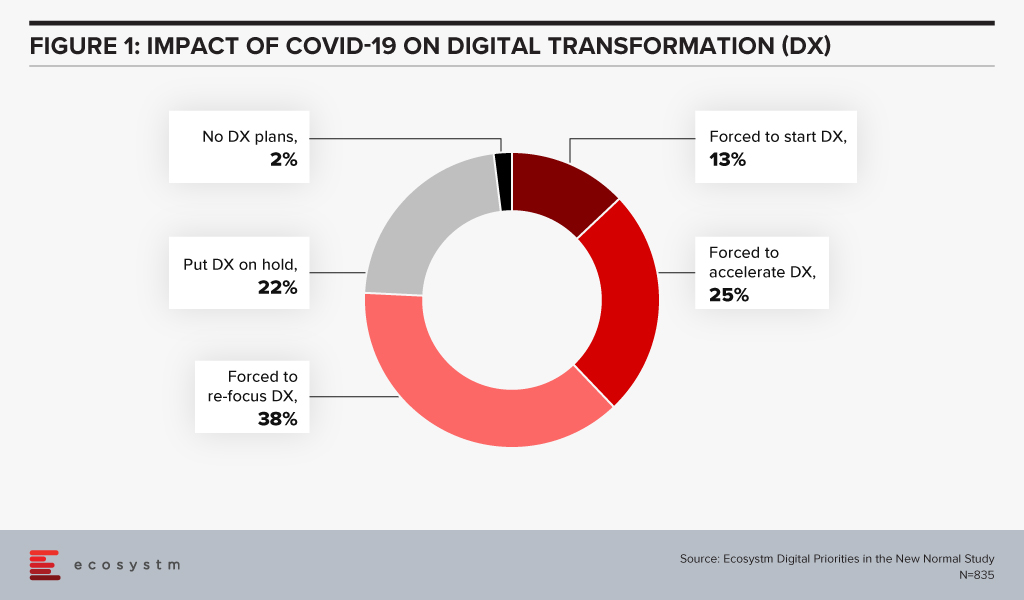
New business models are evolving, and accelerating digitalisation is the result. The digital movement, be it in food delivery or payments, is here to stay. This digital acceptance and absorption exaggerate the need for business models that capture holistic ecosystems and entire customer journeys, due to reasons that separate the hunter and the hunted.
- Margins will never be the same again as in the uni-product model. Using the F&B analogy; with the increasing number of customers wanting to dine in the comfort of their homes, restaurants cannot use ambiance as the price differentiator. Since most restaurants are available on food delivery services, customers are getting brand agnostic. This is the start of commoditisation of dining. Restaurants (or food caterers now!) will need to play the price card to remain competitive resulting in compressed margins. The food delivery market is expected to grow 4-fold to USD 8 billion by 2025 but with lower margins. This example of the food delivery model will be the same as experienced by retail, apparel and other industries.
- Customer experience will still be the differentiator and lever for loyalty and repeat purchase. Factors like proximity, parking, in-store experience, and store layout are fast getting replaced by the ease of navigation, user experience, seamless check out and finally efficient and timely delivery. The ease of transaction including multiple steps of search, assessment, evaluation, payment and delivery is of paramount importance. Customers do not want fractured journeys with multiple drop-offs. A unified seamless journey will win.
- Virtual, Digital and Automation are the three mantras that management consultants are betting on. However, this trilogy will not guarantee survival since the road to recovery is not a straight one. Different work schedules, observing various curves and on what point of the curve the business, its customer and the market are at, will add to the complexity of decision making and transformation.
Given the above, an obvious strategy to beat the existential crisis is to transform and seek out sustainable operating models. However, it may not be so simple since most businesses may not be able to change models as quickly as needed. There is an inherent cost to change since the existing processes and procedures have been well oiled and smoothed over time. The much-needed change requires the infusion of the 3Ts (time, technology, training) and associated costs. Most often, there is an inverse correlation noticed between the sturdiness of the business and its ability to be flexible to change. Businesses that are “rock-solid” and profitably sturdy and stable, have high inertia of transformation versus FinTech businesses, as an example, that pride themselves with nimble operations but are financially fragile and may not be able to absorb the cost of speedy transformation.
This Sturdy-Flexible continuum is the tight rope walk that businesses will need to walk in this need for transformation. Businesses that embark on this walk alone will find it extremely painful and lonely. Especially in the case of small business owners who are scared and low on all 3Ts.
The Rise of Ecosystems
The new world has manifested that businesses that use physical space or assets as their competitive advantage are more prone to be impacted. Retail, Education, Hospitality and Entertainment are some obvious examples that have been impacted by the physicality in their propositions. Digital businesses are more agile but have suffered in their inability to scale up in time to capture the increased demand.
Fashion retailer FJ Benjamin has decided to shut 300 physical stores and rely on online sales. This strategy also helps to utilise precious time to scale diversification. Other retailers too have been going down the FJ Benjamin path and ramping up eCommerce as this trend is expected to stick beyond COVID-19.
Zouk, the renowned nightclub with 30,000 square feet of space in Singapore uses this venue as a live streaming venue during the day to host bazaars for eCommerce vendors. From June 2020, it launched an online shop selling merchandise, bottled cocktails and food from its RedTail kitchen.
Transformation of businesses will require capabilities that were not created within their models. The instinct to survive in the short term will require businesses to create symbiotic partnerships. This will require some fresh thinking by business leaders.
- Change the “Build” obsession and not try to own every leg of the customer journey. That will not only take time but also distract capital and management.
- Rethink the customer needs – and this time think of the entire journey rather than an inward view of product-market fits. Customer needs are changing at breakneck speeds, so chasing and “building” these “fits” will always remain a common string amongst laggards.
- Connect with like-minded ecosystem players and complement strengths with a single-minded focus on solving customer problems.
- View technology stacks through the lens of your partners. There may be opportunities available from near open source technology solutions.
For example, FJ Benjamin will need the last-mile-delivery capability that will be provided by partners who have optimised in that field, Zouk has tied up with Lazada to host the bazaars and GrabFood is using underutilised taxi capacity to meet the increased demand for food delivery. There are many other examples in the O2O (Offline to Online) space.
This ecosystem approach is also relevant to other sectors like Financial Services. These firms also need to understand the changing consumer needs faster, with a mantra to deliver. Aspire, originally an alternate lending platform has gone through a metamorphosis and transformed into a Neobank. From a uni-product loan provider, it is now solving for a business account, card solution, integration with expense management solutions and continue to provide loans. Capabilities not necessarily built in-house.
The changing world will give rise to business models that will integrate and complement each other. Businesses with an ecosystem mindset will be winners while others might just be relegated to oblivion.

Focused on Digital Transformation? It is now more about how fast you can react to market shifts by using specific infrastructural resources.
This period is about digital acceleration. Cloud automation, artificial intelligence (AI), robotic process automation (RPA) and machine learning are all means to accelerate using infrastructure scalability.
Digital acceleration addresses the pace of change
Enterprises are searching to find unique and innovative ways to leverage cloud infrastructures with automation and intelligence. This is both to modernise and to optimise business processes while decreasing expenses. The speed at which the economic landscape has changed during the pandemic has removed debates on cloud usage:
- Remote work from home (WFH) with the need for video conferencing and collaboration tools has been supported by cloud
- Record amounts of SPAM and hacking attempts during the pandemic have leveraged cloud implementations for key security controls
- Tracking apps and classification and encryption of personally identifiable information (PII) via mobile devices are using cloud technology for greater automation and use of AI
Bandwidth and capacity are needed now. The ability to pivot, turn and shoot forward is critical to surviving and thriving in today’s radically changed marketplace. Cloud enablement can deliver enhanced customer experiences, monetise data assets, and can create new revenue streams by enabling new business models.
Cloud enablement explained
Digital acceleration is driven by cloud enablement, amplifying the enterprise value in the infrastructural investment.
Cloud enablement is an ongoing operational model. It incorporates orchestration, correctly organising teams, and a shift away from thinking only about platforms. The cloud platform is now a launchpad, not the main choice that has to be made. Orchestration is around the business and the business model, not just the technology.
Creating a cloud enablement strategic vision can identify where you need to go. It can provide the necessary requirements for expertise along the journey and deliver rapid, meaningful automation services engagements to deliver unbreakable delivery pipelines and agile cloud operations.
But this also involves managing and adjusting on the fly. Initial platform decisions, rolling out countless configuration changes and adjusting to new cloud investments make cloud enablement a tricky road to manage. Enterprises need to be cloud-smart towards their own business model and their strategy. Whatever configuration (on-prem, hybrid, private, public) combination works is dependent on many factors, including industry, size of the enterprise, employee resources and location.
The goal is implementing secure, flexible, scalable, and cost-effective cloud solutions. To do this requires regular cloud enablement audits as to the state of play and measuring successes.
Building and maintaining modern IT
Modern IT is hybrid and all the pieces that collect and manage the data need to be properly and securely managed. Just as technological (and economic) disruption has generally led to automation and the elimination of outdated processes, it has also always created new ideas and innovations.
One way to make your organisation more data-centric and digital is to selectively invest in those technology choices that are most adaptable and flexible to business needs. Data is the most strategic of assets and can be empowered by increasingly sophisticated intelligent operations. Process automation and AI help put that data to work by adding valued intelligence and encapsulating information.
Hybrid cloud coordination automated
Hybrid cloud coordination is an increasing enterprise demand, particularly in the Asia Pacific region, leading to enhanced data centres with joint customer support like the new Tokyo interconnection with Oracle and Microsoft Azure. The key to successfully monitoring a distributed cloud ecosystem is not only in gathering data on usage; it’s about knowing which questions to ask to make it more efficient and effective. This includes tracking connectivity speeds, creating common technical support and using single sign-on for better security. Here both AI and automation can help.
In Asia Pacific, the multi-cloud theme is being promoted heavily among integration providers with solutions that can plug into multiple clouds with virtual machine usage. Enterprises value enabled automated orchestration between cloud platforms. There will be a continued need for integrated tools across public and private clouds. This includes advanced analytics and AI as important aspects of an IT infrastructural investment.
Your choice of vendor for AI & Automation
In my opinion, AWS has the broadest AI service capabilities in the Asia Pacific cloud/ AI space, when compared to Microsoft, Google, and IBM. AWS provides users with pre-trained AI services for computer vision, language, recommendations, and forecasting to build, train, and deploy machine learning models at scale.
The Ecosystm VendorScope (Figure 1) rates the leading AI & Automation vendors in Asia Pacific based solely on quantifiable feedback from those who actually procure technology. It becomes clear from the responses that many organisations still start their AI journey through Automation. 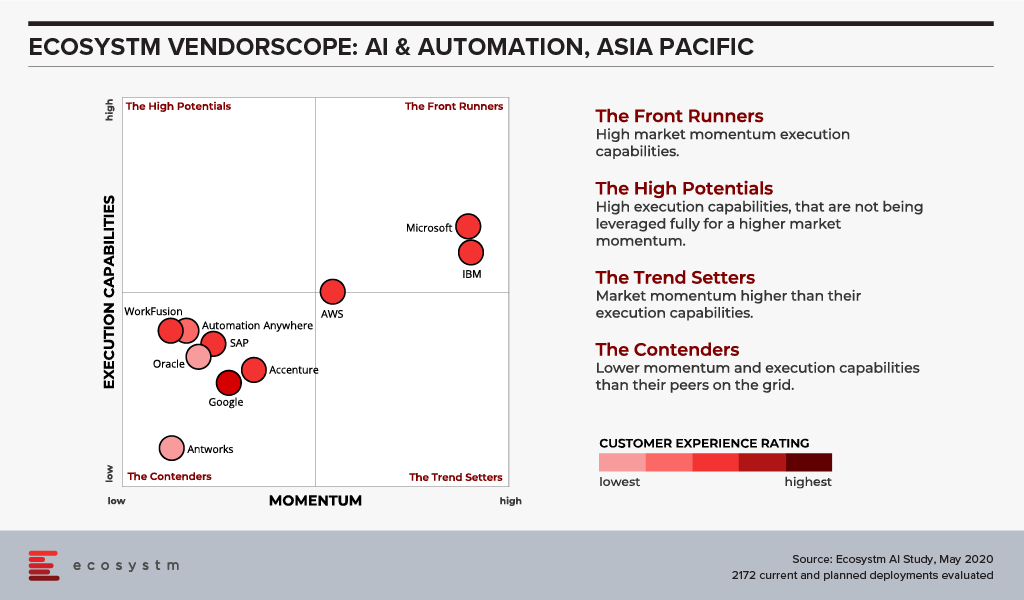
Most organisations understand the importance of leveraging AI to gain competitive advantage. But they do not necessarily know where to start. The secret is that AI is about intelligent process automation, and the firms who understand this are not the ones automating tasks. The use of RPA with vendors such as Antworks, WorkFusion, Arago and Automation Anywhere, leverages automated reasoning using knowledge-based problem-solving engines. These vendors add RPA to AI, not the other way around.
And domain-specific service providers have been creating the synergies for enterprises to link intelligent automation software and industry knowledge to create the necessary end-to-end workflows. An innate understanding of the specific business process is key to leveraging intelligent automation.
Focusing on developing a modern data supply chain process, with actionable analytics insights built into the infrastructure, can aid the development of self-service business intelligence capabilities along with visual data discovery solutions.
Cloud enablement solutions generate maximum business value by enabling IT with scalability and flexibility. This can reduce maintenance and security costs. A focus on cloud intelligence and scalability allows IT departments to concentrate more on innovative solutions, insights and systems that drive significant business growth. Now is the time, and speed is of the essence.
Ecosystm Vendorscope: AI & Automation
Sign up for Free to download the Ecosystm Vendorscope: AI & Automation report.

I’m really excited to launch our AI and Automation VendorScope! This new tool can help technology buyers understand which vendors are offering an exceptional customer experience, which ones have momentum and which are executing and delivering on their promised capabilities. The positioning of vendors in Ecosystm VendorScopes is independent of analyst bias or opinion or vendor influence – customers directly rate their suppliers in our ongoing market benchmarks and assessments.
The Evolution of the AI Market
The AI market has evolved significantly over the past few years. It has gone from a niche, poorly understood technology, to a mainstream one. Projects have moved from large, complex, moonshot-style “change the world” initiatives to small, focused capabilities that look to deliver value quickly. And they have moved from primarily internally focused projects to delivering value to customers and partners. Even the current pandemic is changing the lens of AI projects as 38% of the companies we benchmarked in Asia Pacific in the Ecosystm Business Pulse Study, are recalibrating their AI models for the significant change in trading conditions and customer circumstances.
Automation has changed too – from a heavily fragmented market with many specific – and often very simple tools – to comprehensive suites of automation capabilities. We are also beginning to see the use of machine learning within the automation platforms as this market matures and chases after the bigger automation opportunities where processes are not only simplified but removed through intelligent automation.
Cloud Platform Providers Continue to Lead
But what has changed little over the years is the dominance of the big cloud providers as the AI leaders. Azure, IBM and AWS continue to dominate customer mentions and intentions. And it is in customer mentions that the frontrunners in the VendorScope – Microsoft and IBM – set themselves apart. Not only are they important players today – but existing customers AND non-customers plan to use their services over the next 12-24 months. This gives them the market momentum over the other players. Even AWS and Google – the other two public cloud giants – who also have strong AI offerings – didn’t see the same proportions of customers and prospects planning to use their AI platforms and tools.
While Microsoft and IBM may have stolen the lead for now, they cannot expect the challengers to sit still. In the last few weeks alone we have seen several major launches of AI capabilities from some providers. And the Automation vendors are looking to new products and partnerships to take them forward.
Without the market momentum, Microsoft and IBM would still stand above the rest of the pack – just not as dramatically! Both companies are not just offering the AI building blocks, but also offer smart applications and services – this is possibly what sets them apart in an era where more and more customers want their applications to be smart out-of-the-box (or out-of-the-cloud). The appetite for long, expensive AI projects is waning – fast time to value will win deals today.
The biggest change in AI over the next few years will hopefully be more buyers demanding that their applications are smart out-of-the-box/cloud. AI and Automation shouldn’t be expensive add-ons – they should form the core of smart applications – applications that work for the business and for the customer. Applications that will deliver the next generation of employee and customer experiences.
Ecosystm Vendorscope: AI & Automation
Signup for Free to access the Ecosystm Vendorscope: AI & Automation report.

There has been a widespread adoption of hybrid and multi-cloud architectures in the recent past and this trend is only expected to go up in the near future. A hybrid cloud adoption has its challenges though; including the need for organisations to baseline their security practices across so many different environments. Organisations that are aware of the cybersecurity risks associated are increasingly looking for external specialised help in managing their cloud security measures, especially with an aim to automate the processes.
Zscaler Acquires CloudNeeti
In a recent announcement, Zscaler announced its intentions to acquire Cloudneeti, a niche Cloud Security Posture Management (CSPM) start-up based in Redmond, Washington. This is set to expand Zscaler’s Cloud Security Platform capabilities to include data protection. With this acquisition, Zscaler will be able to complement its own offerings to provide:
- A complete Data Protection and Exposure Prevention suite, that works across locations, users and applications and ensures better compliance with regulations
- A Unified Compliance Assurance platform that provides compliance visibility and breach mitigation across the multiple SaaS applications an organisation uses
- Risk Reduction through automated remediations following both industry compliance laws and organisations’ own risk management program guidelines
Ecosystm research finds that organisations are struggling with their cybersecurity implementations, especially as the solutions get increasingly complicated to combat the complex and evolving threat environment (Figure 1). Integration with existing cybersecurity measures, and a lack of sufficiently skilled IT staff to handle the myriad needs of the multiple systems and applications, builds a strong case for automation in cybersecurity practices.
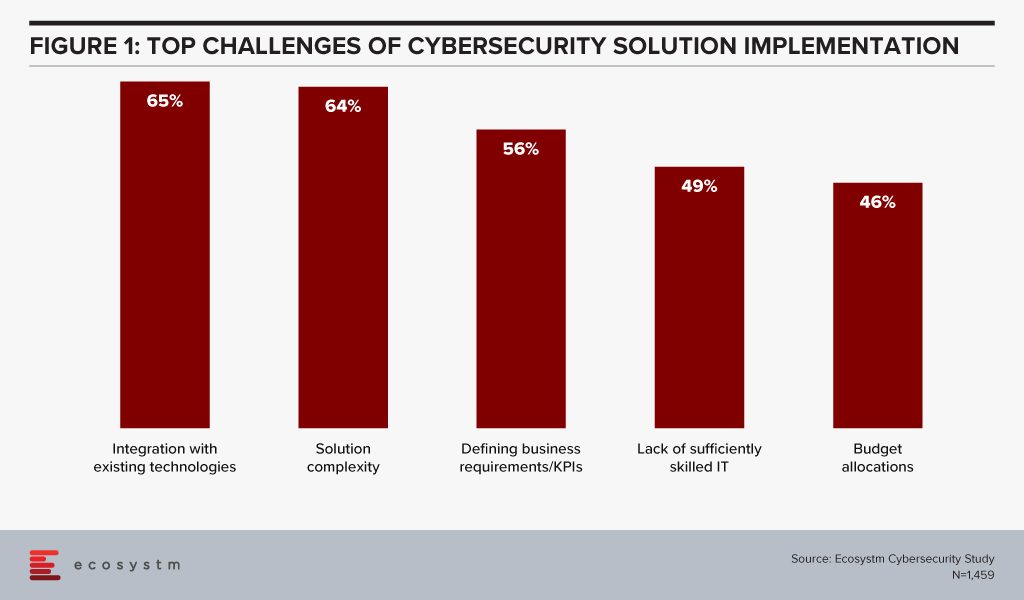
Ecosystm Principal Advisor, Alex Woerndle says, “Automation is critical in cybersecurity, given the volume of data, alerts and incidents that are being dealt with on a daily basis, globally. Automating recurrent and high-volume tasks is a critical step in getting on top of this challenge.”
Importance of Automating Cybersecurity Processes
Woerndle sees a growing role for CSPM providers for multiple reasons. “Firstly, a lot of companies are finding that they cannot be ‘fully cloud’ and as such, end up with a complex architecture spanning on-premise, private cloud environments and multiple public cloud tenancies. Secondly, due to poorly planned cloud migrations, changing priorities, differences in service requirements, cost differences and also personal preferences across multiple teams, a lot of companies end up consuming different services across multiple public cloud providers (Azure, AWS, GCP, and so on). IT teams are struggling to be experts in all aspects of the shared responsibility model and with the capabilities to secure the various services. Finally, there is a constant stream of upgrades and addition of new services team members, given the easy accessibility public cloud environments provide. CSPM solutions provide the ability to establish baselines, enforce security controls and run regular checks to ensure compliance. Doing this manually is time consuming, expensive and always three steps behind.”
Woerndle also sees further complications because of the COVID-19 crisis. “COVID-19 has shifted the world to remote working overnight. Once workers are outside of the trusted corporate network and have access to cloud resources from their home networks, additional complexity to the corporate security posture is highlighted. Depending on how organisations have prepared for this, they either maintain control of all services and applications, and the access into each, or if not prepared, open direct access to a lot of unsecured applications from potentially very unsecured networks.” In fact Zscaler has seen its stock prices rising in the aftermath of the global crisis.
However, Woerndle warns, “While the conversation certainly supports the use of CSPMs, there is a lot more to it in terms of securing home networks, identity and access management, and so on.”
Zscaler’s acquisition of CloudNeeti certainly appears to be a timely move, in the current environment when organisations are struggling with a lack of resources with the extensive knowledge to understand all private and public cloud environments. There are controls required to secure each application, resource and system within an organisation – along with the time and effort required to implement, monitor, audit and improve cybersecurity measures over time.
Having recently taken a security awareness course as part of my annual requirement by my organization, I was thinking about how other assets (besides people) also tasked with roles in the business can better protect the corporate environment. This led to thoughts about the role of the smart building in deterring cyber-attacks. An organization’s information risk profile is defined through a risk assessment of organizational information infrastructure and associated data assets.
So how might the infrastructure of a smart building decrease your organizational risk profile? Can you measure this?
In terms of having an index, I am currently creating an index (like my security awareness course) to rate the level of cybersecurity a building provides to its owners (or lessees). Given we already have sustainability indices for commercial real estate in the form of the CBRE Green Building Adoption Index, my intention is to build a reference cybersecurity metric in how the infrastructure of smart buildings can be compared from the point of those either owning or renting the space. For this index, I will be defining the number of risks, type of risk and potential effects of risk on smart building infrastructural implementations.
Separating control from performance
Physical control of buildings was traditionally seen as separate from enterprise networks. The control systems domain was protected by physical separation, and facilities management was handled as a different domain. However, as global services delivery, data sharing and data acquisition for cost-effectiveness became critical functions within modern business, facilities management became tied to the corporate data network.
Smart buildings now combine legacy operational technology for building automation systems (BAS) together with enterprise IT and IoT devices. Unlike IT environments, which have developed workflows and technologies to address cyber threats, hackers can exploit the vulnerabilities of BAS to enter the IT network and get hold of restricted data located on servers and computers.
The benefits of operation and analytics available for facilities management on how the building performed have given insights into better asset management. But with connectivity has come risk exposure to external exploits and possible attacks.
Life at the Edge
Given edge computing and IoT devices create content for analysis, can they also provide misinformation or redirection for potential attacks on the corporate network? In other words, can the smart building dangle a click bait carrot or honey trap for potential hackers to pull them off the scent of the main system?
Just as we have access layers of data security based on roles within the enterprise, perhaps we should start looking at creating a separate operational data layer for physical control of the building, with the building taking an active role in its own defense. IoT technology, such as sensors, can automatically transfer an office area to ‘vacant’ security mode so potential hackers cannot gain access by moving the area to preset security settings to optimize network protection. This could also mean terminals off, USB ports disabled, and access secured with physical tokens.
Design to cloak or protect
Another way we can create a buffer to protect those assets by a slight disconnect with better perimeter management. One recent approach is the concept of Airwalls. Tempered Networks defines their Airwall edge services as “identity-defined perimeters that enforce access and segmentation for the systems protected within the Airwall”. This creates the possibility to deploy end-to-end encrypted connectivity around operational assets. An Airwall controls and enforces authenticated network communications between protected systems, while denying access to all unauthorized systems. To my understanding, authorized devices for protected access would be physical objects, not passwords. The goal is to remove the access to the IP address information for the potential hacker by creating an air pocket within the enterprise. For those Star Trek fans reading this, imagine a Klingon cloaking device for the ICS.
From the point of standards, there is the development of the IEC 62443 global set of cybersecurity standards to reduce vulnerability. This is set to improve safety, availability, integrity and confidentiality of systems used for industrial automation and control.
How much risk exists from your operational BAC systems?
Smart buildings can be efficient and effective but can also come with cybersecurity vulnerabilities that can be inadvertently introduced when smart technologies are deployed without the necessary consideration of what controls and patches are required to protect them.
In your cybersecurity planning for 2020, what active role does your operational systems play both in protection and in deterrence? Is your smart building helpful with sensor usage and alerts, or does it create hacking opportunities with disconnects and older communication protocols?
Reach out to have a conversation with me if you are interested in the index I am working on, or you’d like some advice on what cyber risk issues to consider in your infrastructural development.
As technology continues to permeate all aspects of business and influence how employees execute their roles, there is a growing need for more technologically proficient employees to quickly become future-ready. To enable this, organisations need to develop strategies and support parameters to reskill and upskill their workers.
Why the Need to Retrain and Reskill
Retraining and reskilling are nothing new, and industries have witnessed it several times in the past. The Industrial Revolution replaced many workers with mechanised tools and machinery. Workers who embraced change, and learned how to use the machines, replaced those who did not or could not. It is true that every new technology creates its own turbulence. What is unique this time is that the shift is happening faster as technology advances exponentially. So, people need to retrain and upskill quicker if they are to keep pace with the changing technology landscape.
Both manual and cognitive tasks are being empowered by machines and AI algorithms. There is also a shortage of a skilled workforce with the right technical training. Here is why the need for technological skills has increased exponentially over the last few years:
Productivity. Organisations are looking for ways to increase productivity and are spending time on identifying technologies that can help them compete in the future. The introduction of AI and automation is replacing legacy systems and displacing positions such as junior executives, administrative staff, customer service executives and so on. Chatbots and novel interactive robotic companions are offering better productivity with an ability to work 24×7 without taking breaks and can be updated and taught new skills with some minor changes in their algorithm. To understand and to work on AI and chatbot queries, employees require special training and skills. For instance, in a customer care team, if a chatbot is not able to respond to a query it can then be passed to a customer service executive who is able to work in tandem with the AI tool to solve the query.
Profitability. The primary reason why organisations look to technology-driven automation is to create an impact on their profit margin. While making the investment in the technology often requires an upfront cost, once the systems are in place there is a positive impact on productivity and hence more profits. Organisations should ideally invest part of the profits to implement more advanced technology and upskilling their current employees. The lower productivity workers often add up to the costs and reskilling them can save money and lead to more seamless workforce integration. For instance, Fintech is being used increasingly to automate decisions such as instant loan approval, KYC, fraud detection and other financial crimes. This does not remove the need for subject matter experts and those that have experience and expertise in the domain – they can train those automated systems by feeding queries, analysing outputs and helping the organisation improve their automated process.
Avoiding being Obsolete. In this digital era, even individuals possessing decades of work experience might get outdated if they do not keep pace with an evolving landscape. Lacking an ability to understand and empathise with technology is often a consequence of improper training. Employees require training at regular intervals – if they do not have the expertise and cannot give the right feedback to these automated systems, there might be serious consequences. As an example, most organisations planning to procure software will also evaluate SaaS solutions. This requires employees to be flexible to adapt to the Cloud environment and to look beyond the legacy systems that they are comfortable with.
Mergers and Acquisitions. In today’s competitive market, we witness mergers and acquisitions almost on a daily basis, with organisations wanting to gain skills, services, technology and ultimately market share. When a company is bought or merges with another, along with a change in leadership and organisational culture, there is also a change in technology used. If organisations want to retain the expertise of the newly acquired firm, retraining becomes essential. In these new set-ups, what will matter more than seniority is the ability of the employees to adapt to and learn the new technologies.
Being Competitive. Technology is seen as an enabler for business differentiation. Increasingly the twin focus areas for all organisations are customer experience (CX) and employee experience (EX) – how to retain and win both customers and employees. When it comes to outperforming the competition, the technology used for the eCommerce platform, point-of-sale solution, back-office operations – virtually every part of the operation, can be a key component of the overall competitive edge. Having workers that are properly trained in the technology they use, and those who buy into the organisational culture will be a crucial advantage in this competitive world.
How to incorporate retraining and reskilling in your Transformation Journey
Organisations should follow best practices when embarking on reskilling initiatives, in order to rapidly drive ROI. It is always a good idea to invest in people who are invested in your organisation. Amit Gupta, CEO, Ecosystm interviewed Parry Singh, Chief Commercial & Digital Officer, Mediacorp where they discussed how emerging technologies such as AI, are impacting the media industry, how to carry an organisation through the digital transformation journey and how to upskill employees for the future. The key takeaways for organisations looking to retain their valuable staff are:
- Realise that learning is a continuous process. Companies should analyse technologies that will impact their business and their industry. But should also be aware that these technologies will evolve continually. To handle this learning should also be continuous. Walmart, for instance, has set up more than 100 “academies” in the US that provide continual classroom and hands-on training for various positions. Having the right talent in place is critical to the prospects of any organisation.
- Make arrangements for just-in-time learning. Learning works best when people can apply their new-found knowledge and skills almost immediately. Organisations should identify the skills that employees will need in their immediate role. This also helps employees appreciate the value of the training and be open to future upskilling. NUS Business School offers a 3-day course, Leveraging Fintech for Business aimed at leaders and managers, to explore the business impact of Fintech – aimed at entrepreneurs and mid-career financial professionals who wish to upskill and those who are impacted by Fintech. Organisations can provide employees with on-demand learning tools and resources. Tools like mobile apps and online courses can help employees to learn and grow and allow them to engage with the program at their convenience and at their own pace instead of forcing them to adhere to a pre-planned schedule.
- Partner if you do not have the right training process. An organisation cannot always be expected to have the right training resources available in-house – it might also prove to be expensive in the long run. Organisations that lack expertise or do not have enough resources to train and reskill employees, should partner with technology providers and dedicated external training programs. SkillsFuture in Singapore has partnered with IBM to train 2,500 Singaporeans on AI skills within the next three years, in a bid to help them apply AI in areas such as human resources, supply chain management, and media.
Technology-enabled automation will displace some workers while at the same time provide a platform for them to grow their careers and play a larger part in the success of the organisations. Companies can enable this transition through investments in training and education and provide a platform for workers to transition to new jobs. With the right tools, companies can continue to forge a long-term and mutually beneficial association with their employees in the face of rapid and increasing digital transformation.


